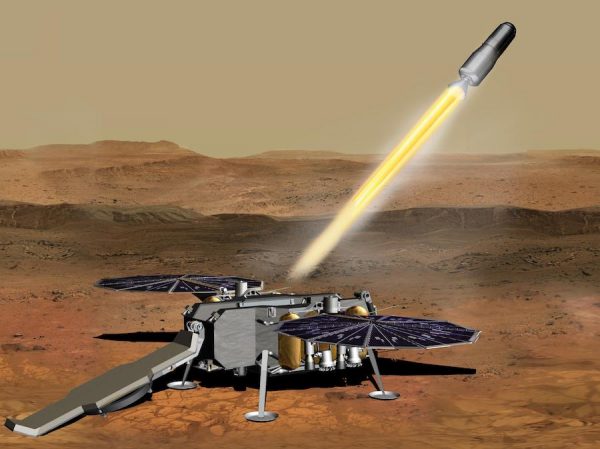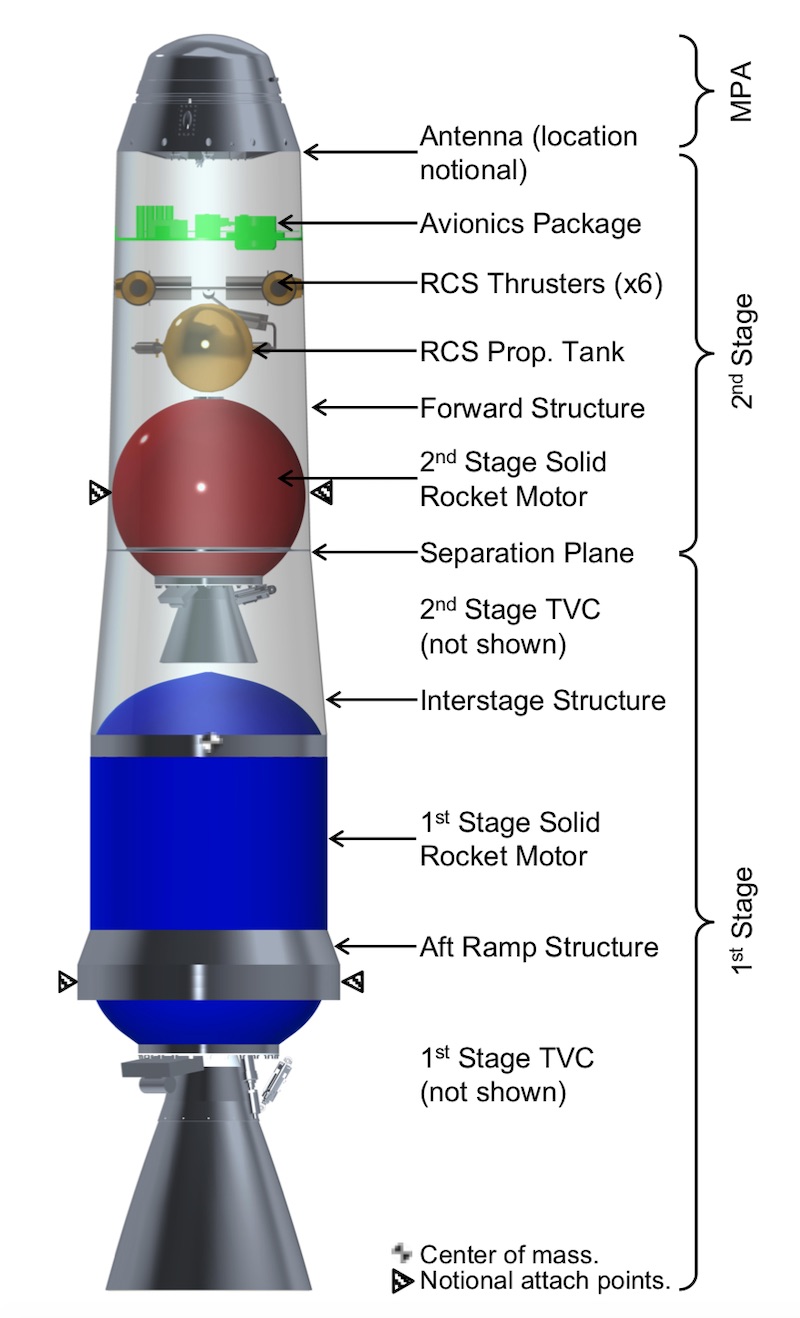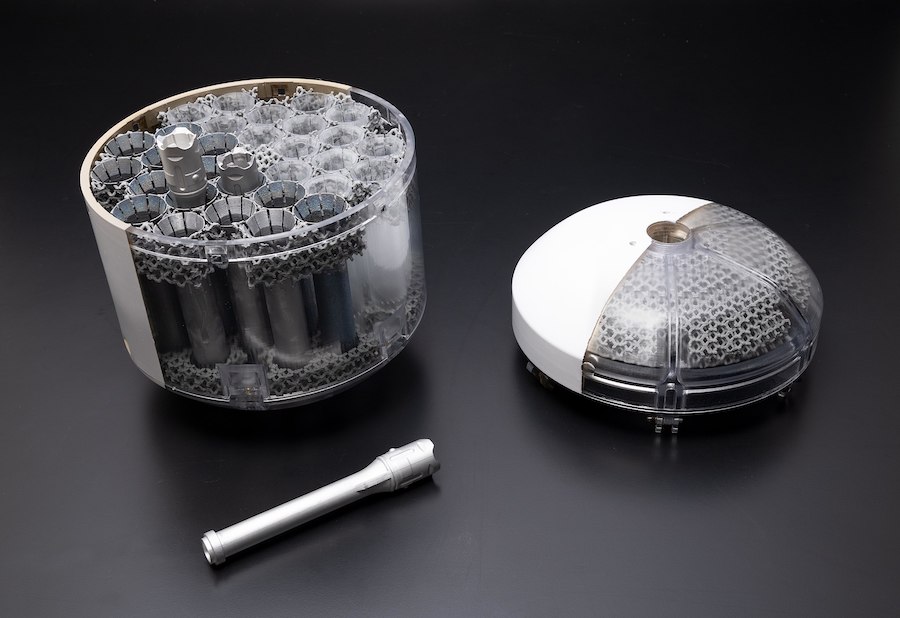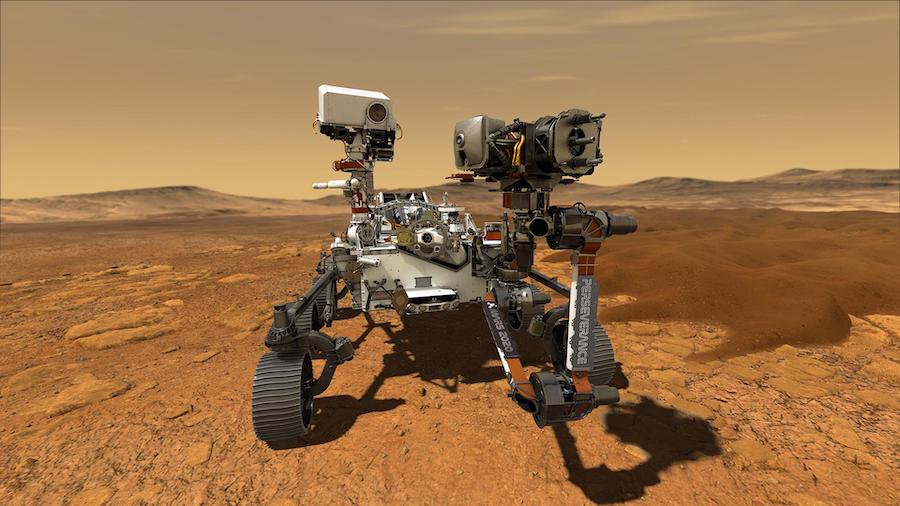NASA narrows design for rocket to launch samples off of Mars – Spaceflight Now

After years of studies, test-firings and a survey of U.S. industry in preparation for launch of a Mars Sample Return mission in 2026, NASA has settled on a solid-fueled design for a miniature rocket with a first-of-its-kind purpose: Launching a payload from Mars for a trip back to Earth.
The small launcher is called a Mars Ascent Vehicle, or MAV. The MAV will play a key role in the Mars Sample Return mission being developed by NASA and the European Space Agency.
The first element of the Mars Sample Return mission is NASA’s Perseverance rover scheduled to depart Earth in mid-July. Perseverance will collect core samples from Martian rocks and store them in tubes for retrieval by a future rover that could launch as soon as 2026.
With two launches from Earth scheduled for 2026, NASA and ESA will send to Mars a stationary landing platform with the MAV, a mobile robot to fetch soil samples collected by NASA’s Perseverance rover, and an Earth Return Orbiter to bring the specimens back home.
The U.S.-built Sample Retrieval Lander will target a landing zone near Perseverance and deploy a European fetch rover to pick up the already-sealed sample tubes and deposit them back at the lander. The tubes will then be robotically transferred into the payload module on top of the Mars Ascent Vehicle, which will launch the samples into orbit around Mars.
ESA’s Earth Return Orbiter, fitted with NASA-supplied hardware to capture and contain the Mars samples, will rendezvous with the specimens in orbit around Mars and contain the alien soil in a return capsule to prevent contamination. Then the spacecraft will depart Mars and head for Earth, deploying the sample-carrying re-entry container to plunge into the atmosphere and crash-land the Utah desert in 2031.
“We’re actively working on humanity’s first round trip to another planet,” said Jim Watzin, director of NASA’s Mars Exploration Program.
With estimated cost of $7 billion, the multi-part mission is ambitious, but NASA officials argue it is achievable.
“When you look at the building blocks for the architecture, they’re all, for the most part, either very similar to the things we’ve done before, or at most an extension,” Watzin said in an interview last week with Spaceflight Now. “The protection of the samples, the containment of the samples, that’s new territory.”
Scientists want to protect the samples not only from contamination caused by terrestrial spores and organic materials from Earth. They’re also focused on ensuring material from Mars does not endanger the Earth ecosystem, a concept known as backward planetary protection.
“We’ve invested for five years now in developing the concepts … and feel pretty comfortable that we have an angle on it,” he said.
“We’re trying to keep this as simple as possible,” Watzin said. “This is by no means a simple task. It is complex -… but you can keep it as simple as possible.”
One of the untried mission elements required for the Mars Sample Return program is the rocket that will boost the rock specimens off of the Red Planet.
Based on preliminary design constraints, the Mars Ascent Vehicle can be no taller than 9.2 feet (2.8 meters) and no wider than 1.9 feet (57 centimeters). Its total liftoff mass must not exceed 881 pounds (400 kilograms).
Martian gravity is just 38 percent that of Earth, meaning a rocket designed to launch a payload into orbit can be much smaller on Mars. And the MAV only has to deliver some 30 to 35 pounds (14 to 16 kilograms) of payload into orbit around Mars.
The requirements stack up to create MAV concept that is tiny by launch vehicle standards, but it’s just enough to do the job, according to NASA engineers.

Engineers at NASA’s Marshall Space Flight Center in Huntsville, Alabama, have determined a two-stage, solid-fueled rocket is the best choice for the Mars Ascent Vehicle.
NASA previously looked at using a single-stage hybrid propulsion system for the MAV, which would have burned a solid wax-based fuel in combination a liquid oxidizer. That made sense, Watzin said, because engineers were concerned the effects of a “cold soak” — or prolonged exposure to cold temperatures — on solid propellant grains.
NASA worked with two hybrid propulsion providers to perform test-firings of hybrid rockets, but agency officials decided in the last few months to go with a two-stage Mars Ascent Vehicle powered by solid rocket motors.
Officials selected Jezero Crater, home to an ancient dried-up river delta, as the landing site for the Perseverance rover, the centerpiece of NASA’s Mars 2020 mission. That makes Jezero Crater the landing site and launch site for Sample Retrieval Lander and the MAV.
“When the landing site was picked for Mars 2020 as Jezero Crater, then the thermal regime that we had to be able to tolerate warmed up significantly, several tens of degrees centigrade warmer,” Watzin said in a recent interview with Spaceflight Now. “So that brought us back into the trade space of also being able to look at solid rocket motors.”
Results from ground testing also showed a single-stage hybrid propulsion system was not quite ready to use in the Mars Ascent Vehicle.
“The test program, the technology program, on the hybrids identified the fact that they still had some work to do in terms of being able to re-light the motors which we needed for the second burn to achieve orbit, and the strategies for providing the right oxidation, the right ignition characteristics that we needed,” Watzin said. “So it was becoming more and more complex and apparent to be less and less mature than what we thought it was.
“Meanwhile, solid rocket motors are very much a known and established entity,” Watzin said. “The technologies are well understood. So the advantages disappeared. We made a selection to go with something that we know and understand, that was not necessarily going to have a big challenge with the new, revised temperature limits that we’re going to face.”
The MAV will launch in mid-2026 with the U.S.-built Sample Retrieval Lander and the European fetch rover. Under current mission plans, the rocket won’t be fired until mid-2029 to begin the return trip to Earth.
Watzin said NASA doesn’t see the long-term storage of the solid-fueled MAV as one of the sample return program’s biggest challenges.
“We think there’s a lot of analogy to what we do here on Earth,” he told Spaceflight Now. “There’s maybe a more direct analogy to missiles in some respects. A lot of missiles are built and stored for years, if not decades, before they’re called into service to operate. So we know how to safely store motors. That’s been done many, many times in both defense and aerospace science research and flight applications.
“All our vehicles these days fly autonomously,” Watzin said. “We’ve been flying around Mars enough that we have a pretty good understanding of the gravity there. So we don’t see that as a big challenge here.”
NASA plans to purchase rocket motors for the Mars Ascent Vehicle from Northrop Grumman, which supplies solid-fueled rocket motors for military missiles and satellite launchers.
“Northrop Grumman, in their recent acquisitions, they bought up a lot of the solid motor capability in the country,” Watzin said. “And they have built — meaning the conglomerate group that they now own — has built solid rocket motors for us in the past with the colder temperature chemical formulations. So we did a market survey and we looked at what else was out there, and it turned out that they’re the ones that have the capability.”
In a sole-source procurement announcement earlier this month, NASA said it intends to award Northrop Grumman a contract to deliver 20 rocket motors — 10 first stage and 10 second stage motors — for the Mars Ascent Vehicle. The motor sets include test articles and primary and backup flight-ready motors, according to the procurement announcement.
NASA says Northrop Grumman collected data from the space agency’s Long Duration Exposure Facility, or LDEF, mission in the 1980s on the long-term exposure of solid propellants to the harsh environment of space for nearly six years. Thiokol Propulsion, which is now part of Northrop Grumman after a series of corporate acquisitions, developed a solid rocket motor for NASA’s Magellan spacecraft that successfully fired after more than 15 months in space to place the probe into orbit around Venus.
According to NASA, Northrop Grumman owns a proprietary solid propellant formulation that could be used for the Mars Ascent Vehicle.
The Trump administration’s fiscal year 2021 budget request would advance development of NASA’s part of the sample return campaign, while ESA member states last year agreed to pay for the early stages of Europe’s contribution. NASA’s Sample Retrieval Lander, the MAV and the European fetch rover would launch from Cape Canaveral in July 2026 on a U.S. rocket, followed later in the year by liftoff of the Earth Return Orbiter from French Guiana on a European Ariane 64 rocket.
“These are the earliest technically and programmatically viable dates to implement this architecture, and it’s the first of only two opportunities that remain prior to the mid-2030s,” Watzin said. “The second opportunity would be in the ’28 timeframe.”
The Earth Return Orbiter will reach Mars first, then use solar-electric thrusters to spiral down into a low-altitude orbit around the Red Planet. Once in place, the orbiter will provide communications relay support for the Sample Retrieval Lander, which will propulsively land on Mars in mid-2028.
Launching the second and third elements of the Mars Sample Return campaign in 2026 will also allow engineers to pursue a solar-powered lander and fetch rover because the critical sample transfer operations will not occur in winter, or during the Mars global dust storm season, said Austin Nicholas, the Mars Sample Return mission lead engineer at NASA’s Jet Propulsion Laboratory.

Mission designers are keeping the option open to use the Perseverance rover — if it’s still operating in 2029 — to deliver the samples to the MAV. That adds redundancy to the plan in case the fetch rover runs into trouble.
“After the surface missions are completed, the MAV will be launched,” Nicholas said. “The MAV launch will be observed by both the fetch rover and Mars 2020, so that will enable understanding of how that event transpired.”
Once the MAV deploys the sample canister in Mars orbit, the Earth Return Orbiter will rendezvous and capture the specimens, then sterilize or contain the Martian material before departing the Red Planet for the trip home.
The return orbiter will release a re-entry module protected by a heat shield to descend through Earth’s atmosphere in 2031 for a crash landing in Utah.
Engineers plan to return the samples without a parachute. Instead, the armored entry vehicle will crash into the ground at high speed.
NASA officials say drop tests show the samples will still be in good condition after a high-speed landing, and the tubes flying on the Perseverance rover were designed with the no-chute return in mind.
Engineers and scientists are concerned about the risk extraterrestrial samples might pose to humans and Earth’s environment, so the entry capsule would have to be designed to withstand a parachute failure.
The Perseverance rover is launching with 43 sample tubes. Five of the tubes will be blanks — they will not be filled with Martian samples — to help scientists analyzing the specimens sort out what molecules came from Mars, and what originated on Earth.
The samples from Mars will be the first returned from the surface of another planet. The material will be sent to laboratories for detailed assessments.
Asked last year about using commercial vehicles, such as SpaceX’s planned Starship, for the Mars Sample Return campaign, Watzin said NASA is focused on using proven technology.
“We knew that we would like do this sooner rather than later, so it didn’t seem sensible to go down a path where we had to develop, from the beginning, a brand new delivery system, when the delivery systems we’re familiar with and have been successful with are adequate to support the execution of the mission,” Watzin said. “If that (Starship) capability matures and shows up, I’m sure programmatically we will take full advantage of it, but it didn’t seem to make sense, since we don’t really know what it’s going to be, or when it’s going to be there, to make it the basis for the campaign.”
He told Spaceflight Now that the most pressing challenge for mission planners is orchestrating the roles of the Perseverance rover and the elements scheduled for the two launches in 2026.
“Portions of it are done individually, but it all comes together into that integrated campaign (at Mars) that takes a little bit over 13 months to happen,” Watzin said. “I think that’s what’s unique. That’s where we’ll have a lot of the challenges.”

A multi-mission campaign to retrieve and return samples from Mars to Earth was ranked as the highest priority in planetary science in by the National Academies in 2011. NASA responded by starting development of the Mars 2020 mission with the recently-named Perseverance rover.
The rest of the sample return program was left open-ended until 2017, when NASA and ESA began detailed planning.
Email the author.
Follow Stephen Clark on Twitter: @StephenClark1.






